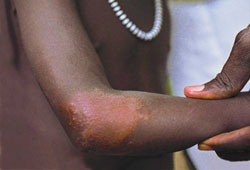შეჯამება
განსაზღვრება
ანამნეზი და გასინჯვა
ძირითადი დიაგნოსტიკური ფაქტორები
- რისკ-ფაქტორების არსებობა
- კანის ტიპური დაზიანებები
- ნერვის ჩართულობა
- მგრძნობელობის დაკარგვა
რისკფაქტორები
- ახლო კონტაქტი მულტიბაცილარული კეთრის მქონე ადამიანთან
- სიღარიბე
- ენდემურ არეში ბინადრობა
- გენეტიკური განწყობა
- ზოონოზური გადაცემა
დიაგნოსტიკური კვლევები
მკურნალობის ალგორითმი
კონტრიბუტორები
ავტორები
Maria T. Ochoa, MD
Clinical Professor of Dermatology
USC Keck School of Medicine
Department of Dermatology
Los Angeles
CA
გაფრთხილება:
MTO declares that she has no competing interests.
მადლიერება
Dr Maria T. Ochoa would like to gratefully acknowledge Dr Denis Paul Jacques Daumerie, a previous contributor to this topic. DPJD declares that he has no competing interests.
რეცენზენტები
Hubert Sansarricq, MD
Member of World Health Organization Panel of Experts on Leprosy
Saint-Armour Morlaas
France
გაფრთხილება:
HS declares that he has no competing interests.
David M. Scollard, MD, PhD
Chief
Clinical Branch
National Hansen's Disease Programs
Baton Rouge
LA
გაფრთხილება:
DMS declares that he has no competing interests.
Alexandre Tiendrebéogo, MD, MPH
Medical Officer
Leprosy and Neglected Tropical Diseases in Central Africa Countries
World Health Organization
Country Office of Kinshasa
DR of Congo
გაფრთხილება:
AT declares that he has no competing interests.
ამ მასალის გამოყენება ექვემდებარება ჩვენს განცხადებას
